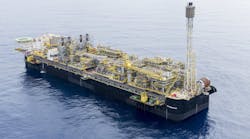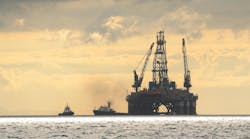Ten tons per sq meter hydrocarbon yield possible from 5,000-meter thick sedimentation zones
Leonard LeBlanc
Editor
- A number of abyssal basinson both sides of the Mid-Atlantic Ridge and bounded by east-west fractures hold substantial thickness of sedimentation and hydrocarbon-rich black shales. The named basins shown here are in water depths of 4,000-5,000 meters.
Three extensive hydrocarbon deposits have been found in 4,000-meter deep abyssal plains off the northwestern coast of Africa. The deposits, from Cretaceous age sediments, were encountered during drilling conducted by the Deep Sea Drilling Project's rig Glomar Challenger and tracked later through other areas by seismic evaluation.
The black shale deposits were cored from an area south of the Cape Verde Islands in the Gambia Basin. Later investigation by seismic vessels determined that the sequences found during coring conducted in the Gambia Basin extended throughout the basin and were found in similar depths in other basins located along the equatorial Atlantic.
The seismic evaluations were announced by E. J. W. Jones of University College London, who participated in geological analysis of the results of the coring and seismic expeditions.
In addition to the hydrocarbon-rich rocks, drillers also found accumulations in water depths as shallow as 800 meters that were rich in phosphorus and ferromanganese oxides. Cobalt levels in some cases were as high as 1%. The phosphate deposits were found in the cappings on seamounts and fault-bounded ridges. One accumulation was located by bottom-towed scintillometer because of the radioactivity issued in the region.
Jones said the hydrocarbon deposits lie in an area of complex terrain surrounding the Mid-Atlantic Ridge, which is displaced eastward 3,700 km with the aid of numerous lateral east-west transform faults. These transform faults or fractures divide up the abyssal areas into basins - Gambia and Sierra Leone in the east and Ceara and Demerara in the west.
Abyssal sediments
A seismic study of the Gambia Basin south of the Cape Verde Islands shows a volcanic floor as the deepest reflector, overlain by sediment. Three other reflected seismic sequences were identified in the sedimentation.
During drilling at the site (DSDP No. 367), the Glomar Challenger cored 150 meters of black shales, which were located just below the second reflector. The sediments were laid down during a long period of basin stagnation.
Analysis of the drilling cores showed a 34% planktonic kerogen level with high hydrocarbon and hydrogen ratios. Jones said that compared with other deepwater deposits in the world's oceans, the Gambia Basin had some the highest hydrocarbon ratios known, exceeding 10 tons per sq meter, if it is assumed the source rock is buried to a depth at which maturation of kerogen would occur.
Seismic profiles show the reflector (No. 2) atop the black shale zone shows up over a wide area of the equatorial Atlantic. Jones said that thickness in the Sierra Leone, Guinea, and Demerara basins were equal to or greater than the Gambia Basin zones.
Cretaceous deposition
The depositions indicate a very different oceanic environment 100-200 million years ago from what exists today near the equator. During the Cretaceous period, when the African and South American continents were quite close together, the deep basins were narrow and bounded by long fracture ridges, that were near sea level. Water flow through the gap between the two continents was frequently restricted. Bottom water stagnated as a result and became very dense.
Jones said that seismic studies conducted beyond the basins shows the shales continued beneath the thick sedimentary aprons along two equatorial margins:
- Off Senegal: Reflector 2 onlaps an irregular reflector forming a structural high, which could be a large reef of Cretaceous or Jurassic age formed on thinned continental crust.
- Off Guinea: On the southern side of the continental rise near the Guinea Plateau, Cretaceous black shales have been found in cores conducted in a canyon at a water depth of 1,657 meters. The sediments were deposited under oxygen-poor conditions.
Jones said the primary targets for drilling evaluation to determine the extend of hydrocarbons under the equatorial Atlantic are the Sierra Leone, Guinea, Ceara, and Demerara basins, since the sedimentary layers are well defined. Drilling is also needed to define petroleum traps beneath the continental slope and rise where Cretaceous shales and a thick sedimentary overburden offer good prospects. Deep carbonate reefs also could act as reservoirs.
The Guinea Plateau offers one of the best near-term targets for exploration of some of these trends. Water depths above some parts of the area are within the range of present technical drilling and production capabilities. The region is underlain by sedimentation layers at least 5,000 meters thick and largely Mesozoic in age.
Reference:
Jones, E.J.W., Deep-Sea Mineral Resources in the Equatorial Atlantic: Recent Exploration and Future Challenges, 1994.Copyright 1995 Offshore. All Rights Reserved.




